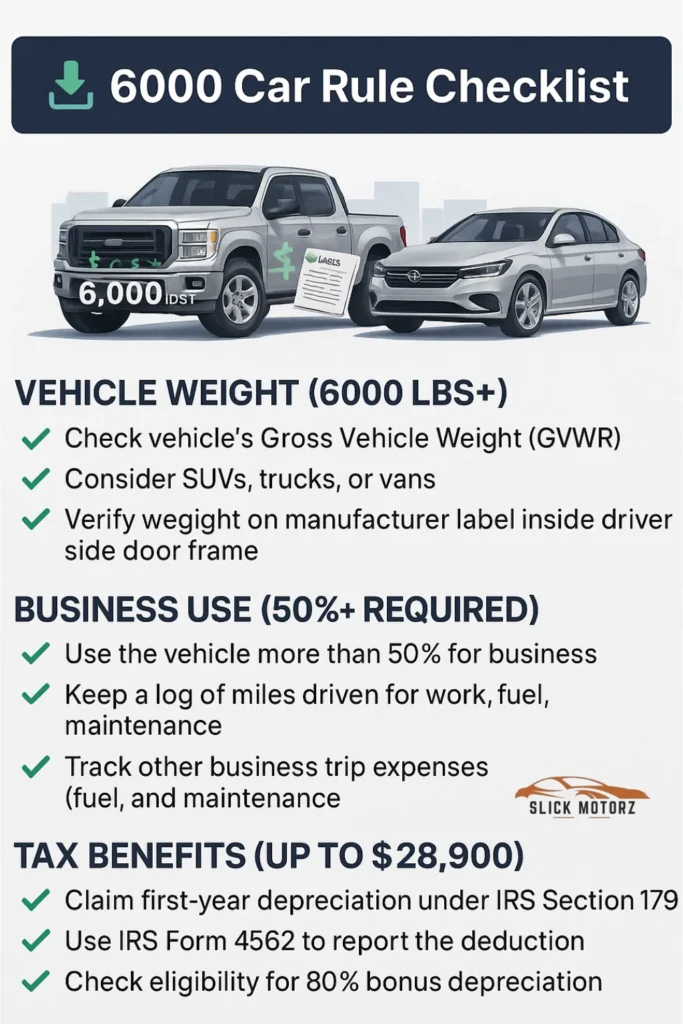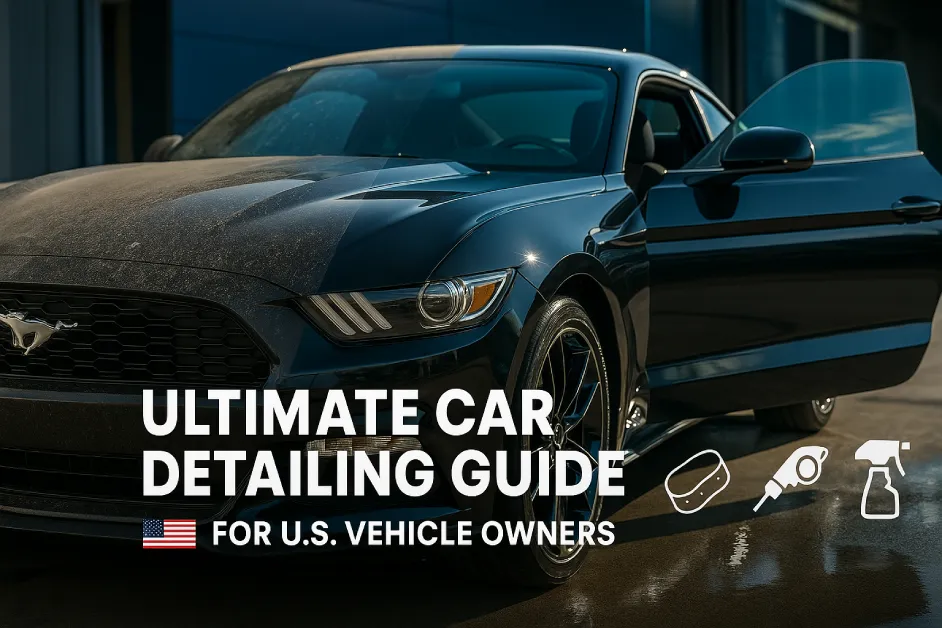Are you curious about the mysterious “6000 Car Rule” and how it might impact your financial decisions? You’re not alone.
Many people have heard whispers about this intriguing term, but few understand its true meaning and potential benefits. Imagine a rule that could influence your tax savings and vehicle purchases. Sounds interesting, right? We’ll unravel the mystery behind the 6000 Car Rule, exploring its origins, purpose, and how it could affect your wallet.
By the end, you’ll have a clear understanding of whether this rule can be a game-changer for you. So, are you ready to uncover the secrets of the 6000 Car Rule? Let’s dive in!

Credit: charlotteledger.substack.com
The 6000 Car Rule Explained
The 6000 Car Rule is a tax regulation. It offers potential savings for business owners. This rule applies to heavy vehicles. Specifically, those with a gross weight of over 6,000 pounds. Understanding this rule can maximize tax benefits.
What Qualifies As A Heavy Vehicle?
Vehicles like SUVs and trucks often qualify. They must weigh over 6,000 pounds. Check the manufacturer’s label for the weight. It’s usually found on the driver’s side door.
Tax Benefits Of The 6000 Car Rule
This rule allows significant deductions on taxes. Business owners can deduct the full purchase price. This is in the year they buy the vehicle. It reduces taxable income, saving money.
Who Can Benefit From The Rule?
Businesses using vehicles for work can benefit. The vehicle must be used for business purposes. Both full-time and part-time use counts. Ensure proper documentation to claim deductions.
How To Claim The Deduction
To claim, file IRS Form 4562. This form is for depreciation and amortization. Ensure all information is accurate. Keep receipts and records for the vehicle purchase.
Common Misunderstandings
Some believe all vehicles qualify. This is not true. Only those over 6,000 pounds do. Also, personal use does not count. Only business use qualifies for deductions.

Eligibility Criteria
The 6000 Car Rule defines eligibility for tax deductions on vehicles weighing over 6,000 pounds. Businesses often use this rule to benefit from significant tax savings when purchasing heavy vehicles for commercial purposes. It primarily applies to SUVs, vans, and trucks.
Understanding the eligibility criteria for the 6000 Car Rule is key if you’re a business owner looking to benefit from tax advantages. This rule, part of the IRS Section 179 deduction, allows you to deduct the cost of qualifying vehicles used for business purposes. But what makes a vehicle eligible for this rule? Let’s break it down step by step.
Vehicle Weight Requirements
To qualify for the 6000 Car rule, your vehicle must weigh over 6,000 pounds. This is the Gross Vehicle Weight Rating (GVWR), which you can usually find on the vehicle’s door frame or in the owner’s manual. SUVs, trucks, and vans typically meet this requirement. Is your vehicle close to this weight? Double-check the weight specifications. An SUV you considered luxurious might actually offer unexpected tax benefits.
Business Use Specifications
It’s not just about the weight; how you use the vehicle matters too. The IRS requires that the vehicle be used more than 50% of the time for business purposes. This means if you primarily use your SUV to ferry kids to school, it might not qualify. Consider tracking your mileage. Tools like mileage tracking apps can help you keep a precise record of how often you’re using the vehicle for business. This record is crucial for proving your eligibility if the IRS asks questions. Have you considered how this rule could impact your business? The ability to write off a significant portion of a vehicle’s cost can make a big difference in your financial planning. Engage with these criteria and ask yourself if you meet them. If you do, the 6000 Car Rule might be a valuable tool for your business strategy.
Tax Benefits Overview
The 6000 Car Rule can be a game-changer for business owners like you. It allows significant tax savings on vehicles weighing over 6000 pounds used for business purposes. This rule can be the key to reducing your taxable income, ultimately helping your bottom line. Imagine driving a substantial asset that not only serves your business needs but also provides financial relief.
Deduction Options
Under the 6000 Car Rule, you have several deduction options. You can choose between deducting the entire cost of the vehicle in the first year or spreading it over several years. This flexibility allows you to decide what’s best for your financial situation. Would you prefer an immediate financial boost or a steady deduction over time?
Many business owners opt for the Section 179 deduction. It lets you write off the entire cost of qualifying vehicles immediately. However, it’s crucial to ensure the vehicle is used primarily for business purposes. Consider consulting a tax professional to make the most of these options.
Depreciation Benefits
Depreciation benefits are another advantage of the 6000 Car Rule. Vehicles depreciate over time, and you can claim this as a tax deduction. This helps offset the cost of the vehicle over its useful life. Are you aware of how much your car’s value decreases each year?
For vehicles over 6000 pounds, you can use bonus depreciation. This allows you to deduct a substantial portion of the vehicle’s cost in the first year. It’s a practical way to manage expenses and reduce taxable income effectively. Ensure your records are accurate to avoid any issues with the IRS.
With these benefits, the 6000 Car Rule can be a powerful tool in your financial strategy. Consider how it might work for your business needs and take advantage of the tax relief it offers.

Credit: getdriversed.com
Calculating Deductions
Calculating deductions for vehicle expenses can be complex. The 6000 Car Rule simplifies it. It allows businesses to deduct expenses for heavy vehicles. These vehicles must weigh over 6000 pounds. Understanding deduction methods is crucial. It helps maximize tax savings.
Standard Mileage Rate
The standard mileage rate method is straightforward. It involves multiplying miles driven by the IRS rate. This rate changes annually. It considers fuel, maintenance, and depreciation costs. You must track miles accurately. A detailed log is essential.
Actual Expense Method
The actual expense method is detailed. It requires tracking all vehicle-related costs. Include fuel, repairs, insurance, and depreciation. Calculate the percentage of business use. Apply this percentage to total expenses. Keep all receipts and documentation. This method can be more beneficial for high-expense vehicles.
Advantages For Business Owners
The 6000 Car Rule offers significant benefits for business owners. This tax incentive can help companies save money and invest wisely. Understanding these advantages can enhance your business strategy.
Cost Savings
One major benefit is cost savings. The rule allows businesses to deduct up to $25,000. This deduction applies to eligible vehicles weighing over 6,000 pounds. The deduction reduces taxable income, saving money on taxes. Businesses can reinvest these savings into operations or growth.
Investment Opportunities
Purchasing a qualifying vehicle can be a smart investment. These vehicles often have better resale values. They can also enhance the company image and client perception. Additionally, larger vehicles can provide practical benefits. They offer more space for equipment or products.
Potential Drawbacks
The 6000 Car Rule offers tax benefits for heavy vehicle purchases. Yet, it comes with certain drawbacks that buyers should consider. Understanding these potential downsides helps in making an informed decision.
Eligibility Challenges
Not every vehicle qualifies for the 6000 Car Rule. Vehicles must weigh over 6,000 pounds. Many cars and smaller SUVs don’t meet this requirement. This limits the options available for buyers. Checking the manufacturer’s specifications is crucial. Ensure your choice fits the eligibility criteria.
Long-term Financial Implications
The tax benefit might seem appealing upfront. Yet, it can lead to unexpected expenses later. Large vehicles often have higher maintenance costs. Fuel consumption is also greater, impacting your budget. Resale values can be lower than lighter cars. Consider these factors before making a purchase.
Comparing With Other Tax Benefits
Understanding the 6000 Car Rule is essential for smart tax planning. It allows businesses to deduct the full purchase price of qualifying vehicles. Comparing this rule with other tax benefits helps in making informed decisions. Let’s dive into how it stacks up against the Section 179 Deduction and Bonus Depreciation.
Section 179 Deduction
Section 179 Deduction lets businesses deduct costs of certain assets. This includes machinery, equipment, and vehicles. The deduction applies to vehicles used for business. The 6000 Car Rule aligns with Section 179. Both offer significant tax relief. Yet, Section 179 has a limit on the total deduction amount. The 6000 Car Rule does not have this cap.
Bonus Depreciation
Bonus Depreciation offers an immediate deduction on asset purchases. This includes vehicles over 6000 pounds. The percentage deducted can be quite high. The 6000 Car Rule complements Bonus Depreciation well. Both options allow for substantial tax savings. Bonus Depreciation covers assets purchased after September 27, 2017. The 6000 Car Rule remains a valuable tool, especially for heavier vehicles.
Practical Examples
The 6000 Car Rule lets businesses deduct the cost of heavy SUVs and trucks from their taxes. Vehicles over 6,000 pounds qualify, providing significant tax savings. This rule encourages the purchase of larger vehicles for business purposes.
Understanding the 6000 Car Rule can be daunting, but when you see it in action, it becomes clearer. This rule primarily benefits business owners by allowing them to claim tax deductions on certain heavy vehicles. Let’s dive into some practical examples to see how it works in real-world situations and the advantages it offers.
Case Studies
Imagine you’re a small business owner running a landscaping company. You decide to buy a heavy-duty truck weighing more than 6,000 pounds. This purchase is not just for convenience; it’s a strategic move for tax savings. By using the 6000 Car Rule, you can deduct a significant portion of the truck’s cost in the year of purchase. This deduction lowers your taxable income, saving you money. Another case is a real estate agent who frequently transports clients to view properties. Investing in a luxury SUV that qualifies under the 6000 Car Rule can be a smart financial decision. By claiming the deduction, the agent reduces their taxable income, effectively lowering their tax bill. This extra cash flow can be reinvested into the business, enhancing growth opportunities.
Real-life Scenarios
Consider a photographer who often travels with heavy equipment. They purchase a large van that meets the weight requirement. The 6000 Car Rule allows them to write off a chunk of the van’s cost, making it more affordable. This deduction helps to manage expenses, allowing more budget for new gear or marketing efforts. Think about a family-owned moving business. They upgrade their fleet with a new truck. This truck not only improves service efficiency but also qualifies for a tax deduction. The savings from this deduction can be used to hire additional staff or expand services, directly impacting business growth. Have you ever thought about how your vehicle purchases could impact your taxes? By examining these examples, it’s clear how the 6000 Car Rule can be a powerful tool for managing expenses and maximizing savings. Whether you’re in landscaping, real estate, or photography, understanding this rule can lead to smarter business decisions. Have you considered how such a strategy might benefit you?
Tips For Maximizing Benefits
The 6000 Car Rule offers significant tax deductions for business owners. To make the most of this opportunity, it’s essential to follow some smart strategies. By focusing on record keeping and consulting tax professionals, you can ensure you reap maximum benefits from this tax rule.
Record Keeping
Keeping accurate records is crucial. Track all expenses related to your vehicle. Note mileage, fuel costs, and maintenance. Use a digital app for ease. This ensures nothing is overlooked. Store receipts safely. They serve as proof during audits.
Document the business purpose of each trip. This supports your deductions. Maintain a logbook. Include dates, destinations, and business reasons. Regular updates keep records current. This habit prevents errors.
Consulting Tax Professionals
Tax professionals provide valuable advice. They understand complex tax laws. Their expertise helps maximize deductions. Consult a tax advisor yearly. Discuss the 6000 Car Rule with them. They ensure compliance with regulations.
Seek professionals who specialize in business taxes. Their insights are tailored to business needs. They clarify confusing details. This saves time and reduces stress. Ask questions during consultations. Their answers enhance your understanding.

Credit: www.calt.iastate.edu
Frequently Asked Questions
How Does The 6000 Lb Vehicle Tax Deduction Work?
The 6000 lb vehicle tax deduction allows business owners to deduct vehicles over 6,000 lbs. This falls under Section 179 of the IRS tax code. Eligible vehicles can be partially or fully deducted as a business expense in the year purchased.
Always consult a tax professional for specifics.
How Much Depreciation Do You Get For A Car Under 6000 Pounds?
Cars under 6000 pounds typically depreciate 15%-20% annually. Factors include age, condition, and market demand. Calculate depreciation by multiplying the car’s value by the depreciation rate.
What Cars Qualify For Section 179?
Cars qualifying for Section 179 must be new or used, business-owned, and weigh over 6,000 pounds. Eligible vehicles include certain SUVs, trucks, and vans used for business purposes. Always check current IRS guidelines for specific requirements and limitations.
Is There A Downside To Section 179?
Section 179 can reduce future deductions and lead to higher taxable income later. Carefully assess your business needs before using it. Consult a tax professional to understand potential impacts on your financial situation. Optimize your tax strategy by considering both immediate and long-term financial benefits and drawbacks.
Conclusion
The 6000 Car Rule guides certain vehicle purchases for tax benefits. Understanding it helps businesses make informed decisions. Choosing the right vehicle can save money on taxes. This rule impacts how you manage business expenses. So, it’s worth knowing the details.
Consult with a tax professional to make the best choice. They can provide personalized advice. Stay informed to maximize your business’s potential. Always keep up with changes in tax laws. This knowledge can benefit your business in the long run.
Check out our other articles, What is the 12-Second Rule for Cars and What is the 80/20 Rule for Cars, for safe car driving.















